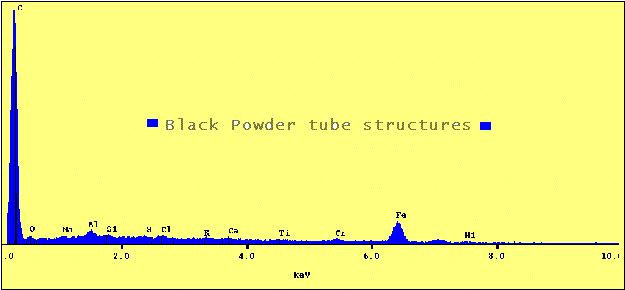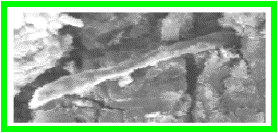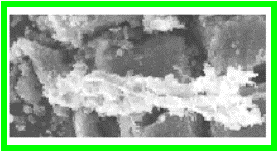Proprietary Technology for Encapsulation of metal clusters in “Fullerene”
Carbon Cages Produces “Magnetic Carbon with Conductive
Properties”
Interesting experiments
Sedimentation
Experiments
Material
analysis Magnets
of carbon
Mysterious magnetic fibers Properties still undetermined
Most probable structure Present day market opportunities
Applications abound
for conductive magnetic carbon some example applications include, xerographic toner and ink jet ink for
printed circuits. Other possible applications include low weight electric
motors, electric propulsion systems, catalyst, semiconductors, computer memory
storage and superconductors.
RW Industries has
developed a new proprietary process for the manufacture of carbon that is both
magnetic and conductive. This new-engineered material is available for
researchers and experimenters to investigate.
The cost for small amounts of magnetic carbon is minimal and further
reduced for university and researchers willing to share experiments and results
with RW Industries. The cost will further drop drastically when produced in
large amounts. If there is interest in purchasing these engineered materials
please call me at 216-381-3831 or email Allisonpeterallison56@yahoo.com. This technology can also be used to insert
other metal clusters into fullerene structures for catalysis, etc.
The conductive magnetic carbon (CMC) has not been fully characterized
but the material is suspected to be similar in structure to fullerenes doped with Fe, Cr, and Ni
impurities.
Experiments show the
resulting deposits of magnetic carbon pulled from suspension by a magnetic
field


Figure1
Figure2


Close up of Figure 1 shows magnetic carbon with structure due to magnetic flux field. Close up of Figure 2 shows
Again, what is believed to be a magnetic flux pattern but
pentagon and hexagon structures are unexplainable
MAGNETIC CARBON SETTLING EXPERIMENT

Figure 3
Magnetic carbon dispersed in methanol will settle out of suspension in 8.37 minutes under the influence of
gravity, while with
the addition of a magnetic field the settling time has been reduced to
2.17minutes.
If the magnet were above the container, then the magnetic
carbon would be held in suspension with out the aid of
rheological additives a new application useful to the paint
industry.
Material Identification
and Characterization
Gravimetric
analysis
|
|
Calcining
sample of magnetic carbon |
|
|
|
|||
|
|
|
|
|
|
|
|
|
|
|
75.80% |
carbon |
|
|
|
|
|
|
|
24.20% |
Metal or
possible trace metal oxides |
|
|
|
|
|
|
|
100.00% |
|
|
|
|
|
|
|
This
analysis may have some error due to trace amounts of steel in sample |
|
||||||
|
(Steel is
Fe,Ni,Cr) |
Due to
this possible error the carbon level is slightly increased |
. |
|||||
|
Other
analysis problems may also bring the carbon content to as high as 83.06% |
|||||||
SEM-EDS analysis
The analysis work was accomplished with Energy Dispersive Spectrometer (EDS) where X-ray back scattering of heaver elements distinguishes heaver metal elements from the lighter ones.

The
resulting analysis data indicate fullerene structures
|
|
|
|
|
|
|
|
|
|
|
|
|
|
|
The
Fullerenes are |
C28,C32.C50,C60,C70,C76,C78,C84,C240,C540 |
|
|
|
|
|
|
|||||
|
|
Empirical
formula calculations |
#1 |
|
|
|
|
|
|
|
|
||
|
Percent
carbon |
|
75.80% |
|
|
|
|
|
|
|
|
|
|
|
Atomic Wt
of Carbon |
12.011 |
|
The basic
ratio for the chemical structure for fullerenes with: |
|
|
|||||||
|
number of
atoms per molecule |
6.310882 |
|
|
13.81874 |
carbon
atom to one metal atom |
or 14
carbon atoms |
|
|||||
|
|
|
|
|
|
structure
that would fit this molecule are: |
|
|
|
|
|||
|
%Metal
Element |
|
24.2 |
|
3XC6,2XC5 |
5XC6,8XC5 |
14XC6,0XC5 |
|
|
||||
|
Ave
Atomic Wt |
|
52.99 |
|
C28 |
|
C70 |
|
C84 |
|
|
|
|
|
number of
atoms per molecule |
0.45669 |
|
2metal
atoms |
5metal
atoms |
6metal
atoms |
|
|
|||||
|
|
|
|
|
|
|
|
|
|
|
|
|
|
|
|
|
|
|
|
|
|
|
|
|
|
|
|
|
The
largest possible error due to metal impurities would result in the following: |
|
|
|
|
|
|||||||
|
component
metals for the average atomic weight |
|
|
|
|
|
|
|
|
||||
|
|
Empirical
formula calculation#2 |
|
|
|
|
|
|
|
|
|
||
|
Percent
carbon |
|
83.06 |
|
|
|
|
|
|
|
|
|
|
|
Atomic Wt
of Carbon |
12.011 |
|
Structures
that fit are |
|
|
|
|
|
|
|||
|
number of
atoms per molecule |
6.858794 |
|
14XC6,0XC5 |
|
|
|
|
|
|
|||
|
|
|
|
|
|
C84 |
|
|
|
|
|
|
|
|
percentage
of metal |
|
16.94 |
|
4 metal
atoms |
|
|
|
|
|
|
||
|
Average
Atomic metal Wt |
52.99 |
|
|
|
|
|
|
|
|
|
||
|
Number of
atoms per molecule |
0.319683 |
|
|
|
|
|
|
|
|
|
||
|
|
|
|
|
|
|
|
|
|
|
|
|
|
|
the
carbon metal ratio is |
21.45499 |
** |
|
|
|
|
|
|
|
|
||
|
|
|
or 21
carbon atoms to 1 metal atom |
|
|
|
|
|
|
|
|||
|
** If the
number were 22 there are no analogs that fit, if you carry out the
calculations further 21 is the closest number |
|
|
||||||||||
|
|
|
|
|
|
|
|
|
|
|
|
|
|
|
|
|
|
|
|
|
|
|
|
|
|
|
|
|
Emperical
Formula #3 |
|
|
|
|
|
|
|
|
|
|
||
|
|
|
|
|
|
|
|
|
|
|
|
|
|
|
Another
way to view the results is to chose only the doped impurities of Fe ,Ni, Cr |
|
|
|
|
|
|||||||
|
|
|
|
|
|
|
|
|
|
|
|
|
|
|
Percent
carbon |
|
75.80% |
|
The basic
ratio for the chemical structure for fullerenes with: |
|
|
||||||
|
Atomic Wt
of Carbon |
12.011 |
|
only iron
is |
14.56175 |
Or 15 |
|
|
|
|
|||
|
number of
atoms per molecule |
6.310882 |
|
structure
that would fit this molecule are: |
|
|
|
|
|||||
|
|
|
|
|
|
5XC6,6XC5 |
40XC6,0XC5 |
50XC6,48XC5 |
|
|
|||
|
%Metal
Element |
|
24.2 |
|
C60 |
|
C240 |
|
C540 |
|
|
|
|
|
Fe atomic
Wt |
|
55.847 |
|
4 Fe
atoms |
16 Fe
Atoms |
36 Fe
Atoms |
|
|
||||
|
number of
atoms per molecule |
0.433327 |
|
|
|
|
|
|
|
|
|
||
|
|
|
|
|
|
Cr
corresponds to 14/1 and Ni corresponds to 15/1 |
|
|
|
||||
|
|
|
|
|
|
|
|
|
|
|
|
|
|
The following SEM-EDS dot maps further prove the proprietary
technology has encapsulated metal clusters to produce “Fullerene” magnetic
carbon that also have conductive properties.







“Fullerene Carbon Magnets”
The following SEM photomicrograph could only go down to 5
microns due to residual magnetism left during
processing indicating the magnetic carbon particles were magnetized
thus keeping the SEM electron beam
from focusing.

Note what appear to be huge fullerene “Bucky Ball” clusters
Tubular shaped rods and
other unknown objects
Strange rod like shaped objects were originally viewed as contamination such as lint or fibers from clothes and other surrounding potential sources. Additionally, they were too large in diameter to be carbon nano tubes (5 microns or .0002 inches) so not much was thought of these foreign objects. It was not until the EDS chart was studied showing the presents of the doping materials Fe, Cr and Ni that it was realized that the contamination was consistent with magnetic carbon components. The major difference was that that the doping materials for the tubular shapes were at a much lower level than Fe, Cr, and Ni in the magnetic carbon powder.






Magnetic Carbon Material Properties
Color –Black Solubility-Undetermined
Form –Amorphous, soot like Density- Estimate >or=1
Melting point-decompose or sublimes Conductivity- conductive
Special Properties- Ferro Magnetic (SEM- no Au coating needed)
Curie Temperature –undetermined Superconductivity-Undetermined
C60 Structure Encapsulation of Metal Cluster atoms


Figure
4 Figure 5
While
there are several conceivable models for encapsulation of the iron atoms, only
Figure 4 which
surrounds the iron cluster fits the analysis
ratio. In Figure 5 the ratio of Fullerene “Bucky ball” carbon atoms to iron
atoms is too high or if the Fullerenes were replaced with individual carbon
atoms, the carbon
to metal ratio is too low. (Blue color =C atoms, red color = Fe
atoms)
Immediate applications for Magnetic Carbon
Measurement of
small differences in low viscosity materials such as the differences in
viscosity of
MEK, methanol,
mineral spirits etc., is easily accomplished using settling rates of magnetic
carbon dispersed
in the solvent.
The application of a magnetic field is used to control the settling rates and
small differences in
viscosity can be
resolved.
Measurement of
polymer molecular weight differences is accomplished using the magnetic carbon
technology,
small differences
in molecular weight (the viscosity difference of solutions) can be resolved.
Coatings
applications: one example is using electrostatic spray systems to reduce over
spray, the same idea can
be applied using
magnetic carbon as a pigment and a magnetic field from a permanent or
electro magnet .
Further, powder
coatings uses the same technology and using magnet carbon as the prime pigment
will allow
(non colored)
coating to be directed to the part to be coated .
Dry toner for
xerographic copy machines, Xerox is said to hold numerous patents for such a
process.
Coatings
applications for hard drive memory storage, magnetic carbon will be easier to
disperse than iron oxide
or carbonyl iron
currently used for this purpose.
Present cost
of magnetic carbon
Presently the magnetic carbon is selling for $50 for 50 milligram plus shipping and handling.
Larger orders are available along with price break
reductions.
To place an order, call or email me for details and current
price at 216-381-3831, allisonpeterallison56@yahoo.com
( Note1, this is only one application of RW Industries
proprietary technology, there is an infinite number of materials that can be synthesized. If
you have specific material properties you are trying to achieve please write or
email us with your specifications)
(Note2, we are currently looking for
investors, venture capitalists, and in general funding for business expansion
purposes)